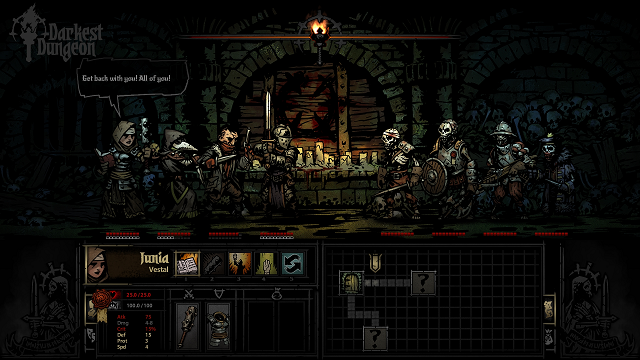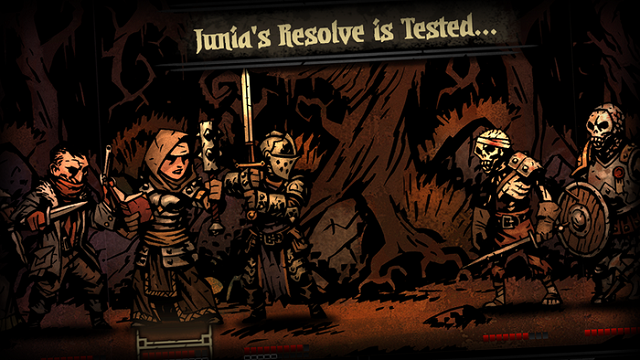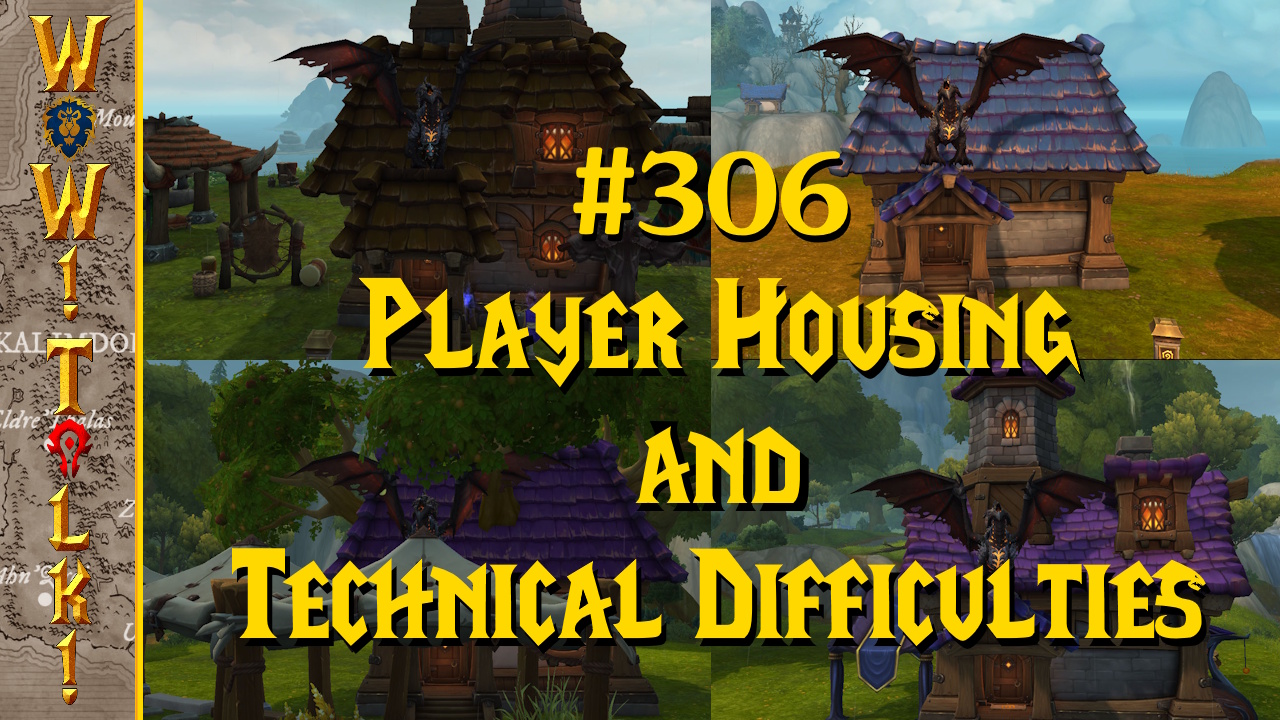I was already really excited for Darkest Dungeon before I’d even played it. The great art style, creepy writing, and promise of insanity and death in a world where madness was personified by hulking horrors skulking halls under the earth just appealed to me on almost every level. Here was a horror/RPG, a mingling of some beloved genres, and it was coming my way. Finally, at PAX East 2014, I got to try it out myself and see if it stood up to the hype I’d built up in myself.
Darkest Dungeon was my “Game of the Show” for PAX East 2014. Hot dang, let’s dig in.
For starters, the combat system and gameplay seem simple, but are rock solid. Your characters are laid out all in a neat 2D row, with enemy characters laid out the same. All classes have various attacks that work better on certain spots within the row. For instance, the knight is melee class so most of his skills only attack enemies within the first row or two, and he can’t hit the back row at all. More interestingly, ranged characters like the plague doctor can only do their best attacks on the back rows, and also only while standing at the back row themselves. This also applies to enemies, which is why you’ll see archers and other ranged characters in the back.
What does this mean for the player? Well, if a character is forced out of their preferred range for some reason, it means that their best attacks won’t work. If you kill the front row of enemies and force the crossbow user to the front, it’ll do less damage. Likewise, if your plague doctor gets shoved to the front, she won’t be able to use most of her abilities. Worse, if your knight gets forced way back, he might not be able to attack at all. Why would he move to the back row, though? I’ll get to that.
I had four attacks per character that I could choose at will throughout the demo. There was no MP or any other ability point to worry about. The only thing I needed to watch out for was my position and which attacks hit what row or area. Each attack hits different positions, some hitting multiple enemies and most only able to hit specific spots. Many of them had varied critical hit chances, and all of this information just popped up in a convenient box when I highlighted the attack. The game is pretty straightforward in this regard, so if everything is all right on your side, all you need to do is pick a plan that prioritizes the enemies you want dead while keeping your own party on its feet. No problem, right?
This is where the game’s sanity system comes into play. On top of a regular health bar, your characters have a sanity bar that goes up or down depending on the amount of weird or soul-crushing stuff your character sees. If you run into an enemy ambush, it will do some sanity damage. If you receive a critical hit or one of your characters dies, your party will take more. If someone becomes unhinged and starts saying crazy things, it’ll continue to whittle away at everyone’s minds. Your party will feed off itself as it deals with the crazy things that live in these dungeons, and if you don’t keep them in check, they’ll develop lots of fun little habits that make death much more certain.
Now, I purposely let my sanity drain so I could see the effects, and there were some doozies. The first one I got was on my knight, who just went plain old crazy. He’d say weird things that I thought were hilarious during the fights, but my party clearly didn’t. More dangerously, he refused healing since he claimed that I couldn’t be trusted since I was a bear. Every time he opened his mouth, the party lost sanity points, and this happened until my highwayman lost his mind and became fearful. This meant that he often ignored my commands, and he kept moving back in the rows, forcing my plague doctor to a range where she couldn’t use any of her attacks except for one little one.
This was made much worse when my stubborn knight dropped dead after refusing any healing again, getting his skull caved in by a skeleton that towered above him. This forced the plague doctor to the front row, where her own life didn’t continue much longer. With a final critical hit, she dropped, sending my cleric over the edge and she became abusive. She taunted the remaining party for the rest of her life, which wasn’t long when my highwayman moved behind her to hide, forcing her right into the attacks of the boss skeleton. She still did sanity damage to my party like a champion before she died, though.
Going crazy made combat quite varied, throwing in all sorts of problems that made my combat choices that much harder to make, which is why I liked them. Combat was already an interesting dance with the varied ranges and abilities, keeping me on my toes as I looked to press any advantage I could find. Would I kill the ranged guys to get rid of their arrows, or just take out the heavy hitters until the ranged guys were useless? Should I pile on status effects (which actually all worked in this game) or just risk the lower damage but higher critical chance attacks? Failure meant further rounds where my sanity dwindled, so every mistake had the real chance of starting me on a slide towards insanity that might lead to my running away or a party wipe. Every move feels loaded with purpose and meaning, and I actually spent a long time deliberating every single attack. It was brutal, and for a guy who’s been playing turn-based RPGs for years, it was magical.
Had many of my characters survived, Creative Director Chris Bourassa said I would have retained those sanity effects permanently unless I got those characters some form of therapy in town, but that wasn’t in the demo. Also, I could have fled the dungeon when things started to go poorly – dropping all the loot I’d found along my way, but leaving with some living characters. Since death is permanent in Darkest Dungeon, you stand to lose a big investment if you let a long-standing character go crazy or die, so there’s a lot more tension involved than I felt while trying to drive my characters nuts.
I could have done a little something about it during my dungeon travels, too. You can camp while poking around the dark hallways if you find a bundle of wood somewhere in your travels (and the characters actually panicked a little bit when I used the last bit of it, remarking that they couldn’t rest any more). Here, you can use some powers that heal your health or sanity, many of which only had a percentage chance of succeeding. You do gain a few hit points and sanity points back for camping, though, so at least you get something back. Then again, there was a sanity healing ability that had a chance of backfiring horribly, and of course it did on me, so the whole point was a bit moot during my playthrough. At least you might get better, though.
I have to admit that my characters looked good while dying. The game uses some great artwork that reminded me a lot of Mignola’s work on Hellboy, both in subject matter and visual tone. It’s rough and dark, but full of neat little details. There’s just something I loved about the fur coat the skeleton nobleman was wearing. The dungeons are also spectacular, even only on a 2D plane. It just looked like I was walking through an old horror comic book filled with decrepit castles and the restless dead. The characters are mainly shown in static pictures on the screen, but when attacking shift to different images of their attack. It sounds like it should be visually boring, but the game does this dynamic zoom with some lighting effects and screen-shaking impacts, which made combat look really sharp. It just clicks really well with the subject matter, too, providing the perfect backdrop for knights to lose their minds.
Reading about Darkest Dungeon just doesn’t do the game justice, though. The subtle challenges of every single move don’t translate well to just writing about it. There is a tension in everything you do, as the chance of failure skyrockets with only a few screw-ups. It may be simple to navigate the dungeon halls and pick which attacks to use, but knowing what to do and when to give up and run is what makes this game hard. The stakes are high with every decision, turning the game into a 2D Dark Souls RPG. Well, maybe a little less punishing than that in the demo, but we do have a great looking, challenging game here. With its successful Kickstarter, I’m hoping to get as much content as I can in Darkest Dungeon so I can play it for a good, long time when it finally comes out.








